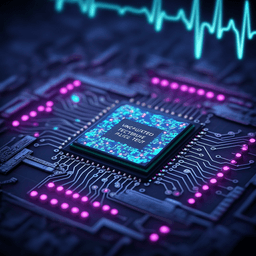
Engineering and Technology
A neuromorphic physiological signal processing system based on VO2 memristor for next-generation human-machine interface
R. Yuan, P. J. Tiw, et al.
Discover a groundbreaking neuromorphic physiological signal processing system utilizing VO2 memristors, achieving remarkable accuracies for arrhythmia classification and epileptic seizure detection. This innovative research conducted by Rui Yuan, Pek Jun Tiw, Lei Cai, Zhiyu Yang, Chang Liu, Teng Zhang, Chen Ge, Ru Huang, and Yuchao Yang showcases the incredible potential of memristors for enhancing human-machine interfaces.
~3 min • Beginner • English
Introduction
The study addresses the need for efficient, low-power processing of physiological signals (e.g., ECG and EEG) for diagnosis and human-machine interfaces. Conventional pipelines rely on ADC conversion, storage, and von Neumann digital processing, incurring heavy data movement, limited speed, and high power consumption. Neuromorphic computing offers a parallel, event-driven alternative better suited to spatiotemporal physiological data. Prior CMOS neuromorphic solutions often suffer from area and energy overheads due to complex auxiliary circuits and large capacitors needed to emulate bio-dynamics. Memristors, with rich ion dynamics and neuron/synapse-like behaviors, are attractive for compact neuromorphic architectures. While hardware LIF neurons are common, fewer works realize ALIF neurons in hardware, and a complete memristor-based system featuring efficient spike encoding and biologically plausible networks with ALIF neurons had not been demonstrated. This work proposes a VO2 memristor-based hardware system comprising an asynchronous spike encoder and an LSNN decision network to efficiently encode and analyze physiological signals.
Literature Review
The paper situates the work within neuromorphic and biosignal processing literature: neuromorphic systems can overcome the von Neumann bottleneck for spatiotemporal signals, but CMOS implementations often require complex control and large capacitors, reducing efficiency. LIF neuron circuits are widely reported; however, hardware ALIF implementations are limited and can be optimized. Event-driven encoding schemes like LC-ADC and delta modulators inspire efficient, on-demand spiking encoders. The authors leverage VO2 memristor properties (symmetric volatile threshold switching) to simplify encoding and neuron circuits relative to prior CMOS and memristor designs, aiming for higher area and energy efficiency.
Methodology
System architecture: The hardware system integrates (1) a VO2 memristor-based asynchronous spike encoder that converts each analog physiological signal channel into two spike trains (UP/DOWN), and (2) a decision system based on a Long short-term memory Spiking Neural Network (LSNN) comprising VO2-based LIF and ALIF neurons.
VO2 memristor device and characteristics: Epitaxial 20 nm VO2 films on c-Al2O3 were grown by PLD (530 °C, O2 at 2.0 Pa, 308 nm XeCl laser, ~1 J cm−2, 3 Hz). Planar devices had 400 nm channel length and 2 µm width; Au/Ti electrodes (40/5 nm) spaced 400 nm patterned by EBL. Devices exhibit volatile, symmetric threshold switching with low cycle-to-cycle variation. Positive/negative threshold and holding voltages show coefficients of variation of 0.65%, 0.86%, 0.31%, and 1.68% over 100 cycles. Switching speeds are <70 ns (off→on) and <60 ns (on→off). Endurance exceeds 6.5×10^6 cycles. Behavior is stable across ambient pressures and in N2.
LIF neuron circuit (VO2-based): A VO2 memristor in parallel with a capacitor Cp and in series with resistor R1; output sensed via R0 (50 Ω). The VO2 TS behavior emulates ion-channel dynamics; Cp represents membrane capacitance. When capacitor voltage exceeds Vth, the VO2 switches to LRS, generating a spike and discharging; when below Vhold, it returns to HRS. Spiking rate depends on R1, input voltage, and parallel capacitance (RC analysis). An LTspice model of VO2 (polarity-independent thresholds, comparator-based switching, finite switching modeled by R0/C0) was developed and matched experiments.
ALIF neuron circuit (VO2-based): Built upon LIF with an adaptive control path requiring few extra components. Spike output is amplified (M1) to drive M2, charging C2 and increasing gate voltage Vg that controls M3, thereby increasing membrane leakage current after each spike (adaptation). Vg decays via R3 (adaptive time constant τa=R3C2) and must be slower than membrane τm=(RVO2+R1)C1. LTspice simulations show spiking frequency modulation by Vg and dependence on M3 W/L; dynamic adaptation under constant input current exhibits increasing ISI until saturation. Tuning knobs include W/L of M2/M3, C2, and R3.
Asynchronous spike encoder (VO2-based): Circuit includes an input amplifier with capacitive-divider gain, an intermediate amplifier (gain α=R2/R1), a VO2 memristor thresholding element, and a feedback reset branch with PMOS/NMOS and resistor Rs. The node gout integrates only when the input changes (law of charge conservation). When the amplified gout across VO2 exceeds ±Vth, VO2 switches to LRS, producing a current that generates a large voltage on Rs to activate the feedback path, resetting gout; VO2 voltage falls below Vhold and reverts to HRS, ending the spike. Positive/negative spikes are separated to UP/DOWN channels with antiparallel diodes. The encoding emits a spike whenever the input increases/decreases by a fixed delta δ (for C1=C2): δ = α·Vth / Roff. Larger α reduces δ (higher fidelity) but increases spike rate. LTspice simulations on sine and typical ECG inputs demonstrate accurate reconstruction from UP/DOWN spikes and sparse, on-demand spiking. Reliability analysis via VO2 Vth fluctuation modeling shows low MSE consistent with low threshold variation.
LSNN decision network: A 3-layer spiking network: input spiking layer, hidden recurrent spiking layer (LIF and ALIF neurons) with a low-pass filter, and an output layer. Synapses include randomly assigned delays. Neuron dynamics mirror circuit behavior with discretized equations: Vm_LIF(t+Δt)=α Vm_LIF(t)+(1−α) R_eff x; Vm_ALIF(t+Δt)=α Vm_ALIF(t)+(1−α) R_eff (x−I_leak), with α=exp(−Δt/R_eff C1). When Vm exceeds effective Vth, it resets to Vhold. Adaptation variable Vg evolves as Vg(t+Δt)=β Vg(t)+(1−β) R3 Iα z with β=exp(−Δt/R3C2). Training uses BPTT with surrogate gradients, total loss combining cross-entropy and spike-regularization to promote sparsity. Implemented in PyTorch/SpikingJelly.
Datasets and preprocessing: ECG (MIT-BIH): 30-min recordings from 48 subjects; resampled to 1800 Hz; split into single heartbeats (~556 ms, 1000 timesteps), normalized to 0–0.6 V; 2000 samples: N=1000, VEB=500, SVEB=250, F=250. EEG (CHB-MIT, patient 1): resampled to 800 Hz; training: 2530 clips (1000 timesteps, 18 channels, ~1.25 s) balanced N/E=1265/1265; testing: 2878 contiguous clips over 1 hour with 31 epileptic clips (imbalanced). EEG post-processing: moving average (window optimized to 9) and thresholding (0.8) on contiguous outputs to improve specificity.
Hardware/electrical characterization: Conducted in probe stations (ambient and cryogenic) using Agilent B1500A SMU and RIGOL MSO8104 oscilloscope; transient behaviors, endurance, and threshold stability measured; external LIF circuit connection per Supplementary setup.
Area and efficiency estimates: With device/circuit optimization, estimated areas: VO2 LIF neuron ~41.3 µm², VO2 ALIF neuron ~53.4 µm²; encoder ~2231 µm²; compared favorably to CMOS/memristor literature in area, speed, and energy.
Key Findings
- Device performance: VO2 memristors exhibit symmetric, volatile threshold switching with very low cycle-to-cycle variations: C(Vth_pos)=0.65%, C(Vhold_pos)=0.86%, C(Vth_neg)=0.31%, C(Vhold_neg)=1.68% over 100 cycles; during ~1000 periods of oscillation, Cv(Vth)=0.73% and Cv(Vhold)=0.48%. Switching speeds: <70 ns (off→on), <60 ns (on→off). Endurance >6.5×10^6 cycles. Stable I–V characteristics across ambient pressures from 3.5×10^3 to 5.0×10^−4 mbar and in N2.
- Encoder: Memristor-based asynchronous UP/DOWN spike encoding preserves precise timing and allows accurate reconstruction of analog signals with sparse, on-demand spikes; delta δ scales inversely with intermediate-stage gain α (δ = α·Vth / Roff). Simulations with sine and ECG waveforms show high-fidelity reconstruction. Robust to threshold fluctuations with low MSE distributions due to low device variability.
- ALIF neuron: Compact VO2-based ALIF neuron demonstrates tunable spike-frequency adaptation via Vg, M2/M3 sizing, C2, and R3; frequency decreases with increasing Vg until spiking ceases when leakage prevents Vm reaching Vth; initial frequency governed by LIF core.
- Arrhythmia classification (ECG, 4-class): LSNN size 3×100×4 (60 LIF + 40 ALIF). Using VO2 encoder (UP/DOWN) plus CUE channel, achieved maximum test accuracy of 95.83% over training (150 epochs). Comparative studies: mixed LSNN outperformed LIF-only by ~18% (4-class) and ~15% (2-class) and was comparable to ALIF-only while using fewer ALIF units, indicating ALIF’s critical role.
- Epileptic seizure detection (EEG): LSNN size 37×40×2 (16 ALIF). Raw LSNN on contiguous, imbalanced 1-hour test set achieved accuracy 82.70%, sensitivity 100%, specificity 82.51%. Post-processing (moving average window 9, threshold 0.8) improved to accuracy 99.79%, sensitivity 90.32%, specificity 99.89%; false positives were effectively suppressed while preserving true positives.
- Efficiency/scalability: Estimated areas: LIF neuron ~41.3 µm², ALIF neuron ~53.4 µm², encoder ~2231 µm², nearly an order smaller than similar encoders. Overall system achieves state-of-the-art metrics with 1–3 orders fewer weights than prior works, suitable for compact wearable devices.
Discussion
The proposed VO2 memristor-based system directly addresses the inefficiencies of traditional and CMOS neuromorphic physiological signal processing by leveraging volatile, symmetric threshold switching to realize compact encoders and adaptive neurons. The asynchronous UP/DOWN encoding preserves timing and amplitude changes with sparse, on-demand spikes, reducing data movement and energy while enabling accurate signal reconstruction. Incorporating ALIF neurons provides spike-frequency adaptation, yielding temporal memory that enhances LSNN performance on spatiotemporal tasks. Empirically, ALIF neurons significantly improved ECG arrhythmia classification and enabled high specificity and accuracy in EEG seizure detection when combined with lightweight post-processing. Device uniformity, endurance, and speed support reliable real-time operation. Area estimates suggest substantial savings over prior CMOS/memristor implementations, reinforcing suitability for next-generation, low-power human-machine interfaces. The results underscore the importance of combining efficient event-driven encoding with adaptive spiking dynamics for temporal biomedical analytics and indicate a pathway toward integrated neuromorphic SoCs.
Conclusion
The work demonstrates a complete VO2 memristor-based neuromorphic physiological signal processing system comprising an asynchronous spike encoder and an LSNN with compact LIF and ALIF neurons. The encoder efficiently converts analog signals into sparse UP/DOWN spikes that retain precise temporal information and allow accurate reconstruction without ADC/DAC or complex control. The ALIF neurons, realized with minimal components, provide adaptive dynamics that markedly boost temporal computing, enabling high performance with small LSNNs: 95.83% accuracy for arrhythmia classification and 99.79% (post-processed) accuracy for epileptic seizure detection. The VO2 devices show high speed, low variability, and long endurance, supporting robust operation. Estimated circuit areas are markedly smaller than prior designs, indicating strong potential for compact, low-power biomedical hardware. Future directions include further device scaling and co-optimization to reduce capacitor area (leveraging parasitics), integrating with non-volatile crossbar memory arrays via appropriate interfacing, expanding datasets to improve robustness and reduce post-processing reliance, and exploring multilayer neuromorphic architectures.
Limitations
- The EEG detection system initially exhibited high false positives (specificity 82.51%) on a highly imbalanced contiguous test set, attributed to limited training data; performance relied on a post-processing step (moving average and thresholding) to reach 99.79% accuracy and 99.89% specificity.
- Area, energy, and speed advantages for neurons and encoder rely on device and circuit optimizations; reported areas are estimates based on optimized parameters rather than fabricated, fully integrated systems.
- While the ALIF neuron’s output amplification stage could drive subsequent layers, multilayer hardware demonstrations were not shown. Further scaling will require careful co-optimization (e.g., reducing or replacing discrete capacitors with parasitics) and validation at nanoscale device dimensions.
- Generalization across broader populations and recording conditions was not exhaustively evaluated; additional datasets and subject variability studies may be required for clinical deployment.
Related Publications
Explore these studies to deepen your understanding of the subject.







